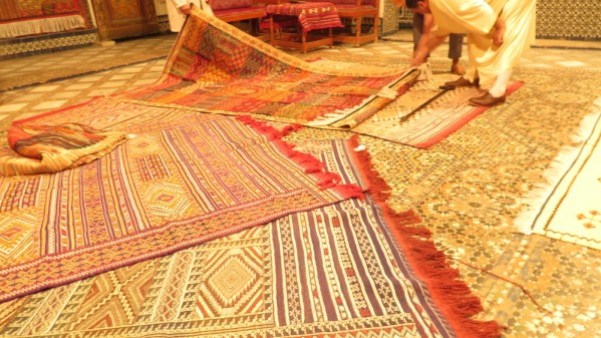The Sunni Side Up
Visits to the Casbah, the souks and the museums mentioned below, as well as the aromas and flavors of the cuisine, made me want to know more about the people of this land. The Berbers that founded the city of Marrakesh circa 1200 were members of that ancient ethnic nomadic group occupying many areas of North Africa. They were Christian under the Romans but converted to Islam with the Arab conquests. With the Arabs they formed what we came to call the Moors- thus not are not sub-Saharan Africans, contrary to some popular conceptions associated with the term ‘Moor.’ Today there are some 25 million Berber speakers in Morocco, Libya and Algeria, but the number of ethnic Berbers is greater as most now speak Arabic, constituting to this day the majority of the population of North Africa.

Their occupation of Spain, headquartered in Granada’s Alambra but covering nearly the entire peninsula, was the most northern permanent excursion of Islamic culture into Europe and it was through this expansion that Europe received the advanced knowledge possessed by these peoples at the time. It is in that epoch that the glory of Morocco and Islam resides, a glory that contains the extent of their innovations.
Both guides we employed told us that the people of Morroco are very tolerant. I can not tell if this is a tolerance founded in the nomadic past, its interpretation of the Koran or the result of, say, French liberalism or other source of humanistic philosophy, but the claim does seem to bear up under what scrutiny I was able to bring to the task. As I noted in my first post, there are no visible tensions between tradition and modernity when it comes to dress. Some women walked around in jeans and other in the hijab without active confrontations or shunning- some even walked together chatting. Men wore kaftans or western dress with equal comfort. These days Jews are actively encouraged to immigrate- most left after the formation of Israel and the last of them after the ’67 war, but Jews have a long history in the country.
As an example of tolerance at the edge, a lesbian woman was jailed but later released after an international outcry, for open affection with another woman. Elton John is being permitted to perform at a spiritual fest, the king saying what Elton does in private is his business, according to the Fes guide.
The King, yes there is one and he is an active ruler. His family claims of direct descent from Mohammed puts the the Sunni side up in this country.
Jardin Majorelle
After our guided tour of the souks in Marrakesh we visited two of the few local museums. One is in the Jardin Majorelle. It was founded by Yves Saint Laurent, who bought the gardens with his partner Pierre Bergé in 1964, later gifting it to Marrakesh,. The original owner was the landscape painter Jacques Majorelle in the 1920’s. In the garden there are 300 species from five continents, along with various ponds laid out along the winding paths. The art deco style Musee Berbere that was Majorelle’s studio now contains an excellent collection of Berber arts and crafts. It is small but the collection is excellent. http://www.jardinmajorelle.com/. Note that vibrant blue paint on the exterior.




The MACMA
Also an excellent visit is the MACMA, a private museum that opened in February, 2016. The owner is Nabil El Mallouki. He dedicated the museum to Morocco’s artistic heritage with a 20th century focus on paintings, some by Moroccans, others by French or European painters. The museum captures what is exotic about Morocco, at least from a European viewpoint, with a collection of quality portraits, casual life and battle scenes.


The Heritage Museum
There are two other private museums worth a visit. The Heritage Museum is in the narrow alleys that define the Marrakesh souk. At the desk we were met by a woman who is the daughter of the owners, the second we met was her sister and upstairs we met their mother. It’s a family affair, They are happy to share their collection with visitors. The museum is in the riad – a house built around an open courtyard – previously owned by the daughters’ deceased uncle filled with the family collection. There are Berber, Arab and Jewish items. The jewelry (a specialty of the Jews), clothing and furniture are delightfully displayed in the beautiful surroundings.

The rooftop cafe offers a fabulous view of the Medina, the souks hidden by the tall walls of the houses.
In a visit of about 10 days you can see what Marrakesh and Fez have to offer, including a side trip to Meknes, interesting enough if you have never seen Roman ruins before. The train between Marrakesh and Fez takes almost 8 hours. There is a sandwich cart in case you’ve not brought food with you, lots of desert countryside dotted with small structures and shepherds. Bring a book since you’ll probably want some diversion.

































